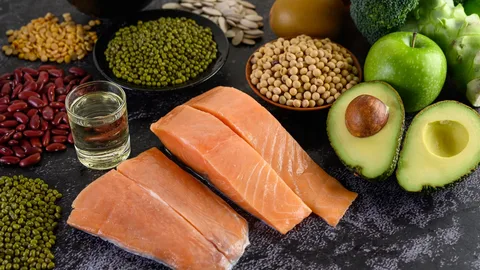Introduction
Vitamin E is a crucial fat-soluble antioxidant that helps protect cells from oxidative stress, supports immune function, and plays a role in skin health. Increasing your vitamin E intake can be beneficial for overall health and well-being. This guide will explore various sources of vitamin E, ways to incorporate more of it into your diet, and answer common questions about this essential nutrient.
Understanding Vitamin E
What is Vitamin E?
Vitamin E is a group of eight fat-soluble compounds that include four tocopherols and four tocotrienols. The most biologically active form is alpha-tocopherol. As a powerful antioxidant, vitamin E helps combat oxidative stress by neutralizing free radicals.
Benefits of Vitamin E
- Antioxidant Protection: Neutralizes free radicals to prevent cellular damage.
- Immune Support: Enhances immune response.
- Skin Health: Protects skin cells and maintains a healthy complexion.
- Eye Health: Reduces the risk of age-related macular degeneration.
- Heart Health: Helps prevent the oxidation of LDL cholesterol.
Dietary Sources of Vitamin E
Nuts and Seeds
Nuts and seeds are among the richest sources of vitamin E. Incorporate these into your diet for a nutrient boost.
Almonds
Almonds are an excellent source of vitamin E. A 1-ounce serving provides about 7.3 mg of vitamin E, which is nearly half the recommended daily intake for adults.
Sunflower Seeds
Sunflower seeds offer a significant amount of vitamin E. One ounce contains around 7.4 mg of vitamin E.
Vegetable Oils
Certain vegetable oils are high in vitamin E and can be easily added to your diet.
Wheat Germ Oil
Wheat germ oil is one of the richest sources of vitamin E, with a tablespoon providing about 20 mg.
Sunflower Oil
Sunflower oil is another great option, providing about 5.6 mg of vitamin E per tablespoon.
Green Leafy Vegetables
Green leafy vegetables are not only rich in vitamin E but also provide other essential nutrients.
Spinach
Spinach is a good source of vitamin E, with one cup of cooked spinach providing about 3.7 mg.
Swiss Chard
Swiss chard offers about 1.9 mg of vitamin E per cooked cup.
Fruits
Certain fruits can also help increase your vitamin E intake.
Avocado
Avocado is a nutrient-dense fruit that provides about 2.7 mg of vitamin E per fruit.
Kiwi
Kiwi is another fruit that contains a decent amount of vitamin E, with one medium kiwi offering around 1.1 mg.
Incorporating More Vitamin E into Your Diet
Breakfast Ideas
- Smoothies: Add a handful of spinach or kale, some kiwi, and a spoonful of sunflower seeds to your morning smoothie.
- Avocado Toast: Spread mashed avocado on whole-grain toast and sprinkle with sunflower seeds for added crunch.
Lunch and Dinner Ideas
- Salads: Include spinach, Swiss chard, and a variety of nuts and seeds in your salads.
- Stir-Fries: Use sunflower oil or wheat germ oil for cooking your vegetables.
- Grain Bowls: Top your grain bowls with avocado slices and a mix of nuts and seeds.
Snacks
- Trail Mix: Create a homemade trail mix with almonds, sunflower seeds, and dried fruit.
- Nut Butter: Enjoy almond butter on apple slices or whole-grain crackers.
Vitamin E Supplements
When to Consider Supplements
While it’s best to get vitamin E from food sources, supplements can be beneficial for those with certain health conditions or dietary restrictions.
Choosing a Supplement
Look for natural (d-alpha-tocopherol) rather than synthetic (dl-alpha-tocopherol) forms of vitamin E for better absorption.
Dosage and Safety
Consult with a healthcare professional before starting any supplement. The recommended dietary allowance (RDA) for adults is 15 mg per day, but higher doses may be needed for specific conditions under medical supervision.
FAQs
What are the symptoms of vitamin E deficiency?
Symptoms can include muscle weakness, vision problems, immune system issues, and nerve damage.
Can you consume too much vitamin E?
Yes, excessive intake of vitamin E, especially from supplements, can cause adverse effects like bleeding problems due to its blood-thinning properties.
How does cooking affect vitamin E in foods?
Vitamin E is sensitive to heat and can be destroyed during cooking. Opt for raw or minimally processed foods to retain its benefits.
Is vitamin E beneficial for the skin?
Yes, vitamin E supports skin health by protecting against oxidative damage and aiding in the repair of damaged skin cells.
Can vitamin E improve heart health?
Vitamin E helps prevent the oxidation of LDL cholesterol, which is beneficial for heart health. However, its role in preventing heart disease is still under research.
Are there any interactions between vitamin E and medications?
Vitamin E can interact with blood thinners and other medications. It’s important to consult a healthcare provider if you are on medication and considering vitamin E supplements.
How does vitamin E support immune function?
Vitamin E enhances immune response by supporting the function of T-cells, a type of white blood cell involved in immune defense.
What is the best time of day to take vitamin E supplements?
Since vitamin E is fat-soluble, it’s best taken with a meal that contains fat for optimal absorption.
Can vitamin E help with hair growth?
Vitamin E’s antioxidant properties can support scalp health and improve hair growth, though more research is needed to confirm its effectiveness.
How does vitamin E protect against oxidative stress?
Vitamin E neutralizes free radicals, preventing them from causing cellular damage and contributing to chronic diseases and aging.
Conclusion
Increasing your vitamin E intake is essential for maintaining good health, supporting immune function, and protecting against oxidative stress. By incorporating a variety of vitamin E-rich foods into your diet and considering supplements when necessary, you can ensure you are meeting your body’s needs for this vital nutrient. Always consult with a healthcare professional before making significant changes to your diet or starting new supplements.
- The Emotional Toll Of Breadcrumbing: How To Protect Yourself - May 31, 2025
- What Are The Top Benefits Of Using CBD Gummy Sweets - May 31, 2025
- Kratom Energy Drinks: A Natural Solution For Afternoon Slumps? - May 31, 2025


